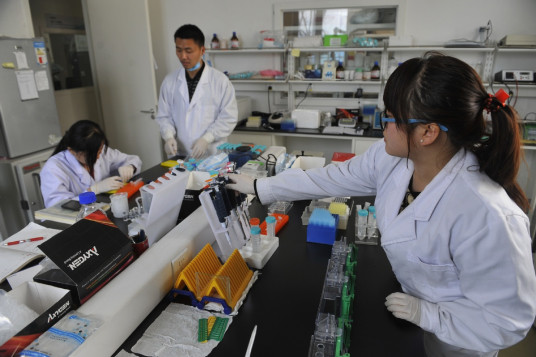Investors seek to back biopharma companies
 |
|
Several researchers work at a biopharmaceutical company in a life sciences park in Gu'an, Hebei province. [Photo/Xinhua] |
Favorable policies, R&D raise visions of a 654 billion yuan market by 2030
Biopharmaceutical companies in China are receiving heightened investor attention of late, experts said.
"China's evolving regulatory policies and enhanced business environment have certainly led to a boom in the R&D (research and development) activity relating to new medicines. Investors have noticed the trend and are rushing to the market," said Han Tao, deputy general manager of China Capital Investment Group, at an event.
Market insiders said firms developing anti-cancer (or anti-tumor) drugs and medicines for autoimmune diseases are likely to find favor.
Unlike conventional drugs made by manufacturing-focused pharmaceutical companies through syntheses of plant- or chemical-based compounds, biopharmaceutical medicines are developed by research-driven biotechnology firms using yeast, bacteria or mammalian cells.
Biopharmaceutical companies in China are receiving heightened investor attention of late, experts said.
"Investors are positive about biopharma prospects, especially after the launch of recent IPO (initial public offering) policies in Hong Kong and Shanghai, which appear to be a great support for companies that are strong in development but lack enough funds," said Han.
He made the remarks at the 15th anniversary of the Cheung Kong Graduate School of Business in Beijing.
Earlier this year, Hong Kong's IPO market opened up to pre-revenue biotech companies. Applicants are no longer required to show a track record of revenue.
In the past, an IPO applicant needed to show it is profitable or has at least HK$500 million ($64 million) in revenue for the most recent audited financial year. In addition, it needed to meet other requirements to be listed on the main board of the Hong Kong stock exchange.
"The (Hong Kong) policy is no doubt great news for companies that develop new medicines. New drug development is a time-consuming and long-term process. Many companies failed in such attempts not because of science and technological barriers but because they lacked money during their early phase. But now, they can access more fundraising channels," Han said.
For its part, the Shanghai Stock Exchange launched a science and technology innovation board, which is likely to offer more financing opportunities to small and medium-sized companies.
Shawn Shi, managing director of HuaGai Healthcare Fund, said: "Shanghai's upcoming high-tech trading platform will also benefit new drug development startups in broadening their fundraising channels, especially for those less qualified to be listed in the past. But some of them have great potential for further development."
Agreed Han. "Accelerated drug approval and more trained professionals coming from overseas are behind the boom."
The National Medical Products Administration is trying to expedite approvals for new medicines by expanding its team to 1,000 people by the end of this year, compared with less than 100 people in 2014.
Han said biotech companies are offering higher compensation to attract top-end scientists and R&D staff, which is expected to help make them globally competitive. "China's major new medicine producers now offer about the same salaries as their counterparts overseas, as against one-third (of compensation in the West in the past).
Most biotech firms' business models are characterized by either independent research or authorized cooperation, Shi said.
Antengene Corp partnered with US clinical-stage pharmaceutical company Karyopharm Therapeutics Inc earlier this year, and obtained exclusive rights for the development of four clinical-stage drug candidates of Karyopharm in Asia.
Anti-tumor drugs dominate the new medicines being developed and are nearing trials, followed by anti-infective and digestive metabolic drugs, Shi said.
According to a report from Valuable Capital Ltd, China's market size of anti-tumor drugs increased from 83.4 billion yuan ($12 billion) in 2013 to 134.9 billion yuan in 2017, with a compound annual growth rate of 13.7 percent.
It will continue to increase at a CAGR of 13.5 percent from 2018 to 2022. By 2030, the market size is expected to exceed 654 billion yuan. "Such market potential is certainly appealing to investors," Shi said.
Targeted drug therapies for treating cancer are among investor favorites, according to a report in China Securities Journal.
Currently, companies engaged in such R&D include Jiangsu Hengrui Medicine Co Ltd and Zhejiang Hisun Pharmaceutical Co Ltd.
"My major concerns, when making investment, are products and teams. How effective is the product compared with those already in the market? How reliable is its clinical data? In addition to scientists who most investors care about, I also look at how good the company's other staff is, like its clinical team," Han said.
"After a drug comes into the clinical stage, the company needs to communicate with patients, doctors, hospitals, and regulatory officials. The marketing is also very important."
